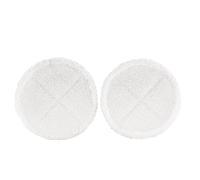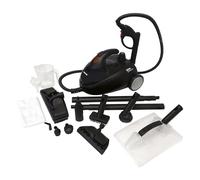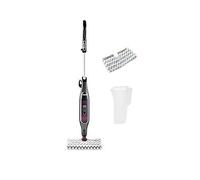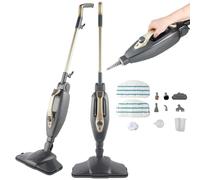Note: This text was created with the help of AI.








































- 1
- 2
- 3
- 4
- 5
- next page
Exclusive Offers on Steam Cleaners
A steam cleaner basically works like a pressure cooker. The water is heated in a closed boiler of the steam cleaner until it boils, so that steam is created. You can dispense this steam in doses via a steam gun or nozzle, for example. The higher the steam pressure, the higher the speed at which it is released and the more effective its power to loosen dirt.
Stubborn and greasy dirt is loosened and liquefied by the steam in seconds. In particular, you can influence the pressure with the help of suitable accessories, so that you can optimally use the steam flow and the high temperature for cleaning.
Using a steam cleaner does not require any effort and you clean surfaces without chemical additives. Many steam cleaners allow you to set different pressure levels to suit the cleaning power and protection of the material to be cleaned.
It is best to use distilled water for your appliance, as limescale and particles from tap water can build up and clog the steam nozzles.
Before using it, you should pay attention to the heating time of the steam cleaner, because the steam needs a few minutes to work effectively. Once your unit has warmed up, you spray targeted hot steam with pressure and carefully go over the area to be cleaned with the cleaning brush or similar device.
After treating the dirty area, you'll need to pick up the loosened dirt with the mop cover on your cleaner or a separate cloth, depending on the power of your steam cleaner.
That depends on the device and the manufacturer. With many cleaners designed for domestic use, the steam in the tank is heated to between 100 and 150 degrees Celsius. In the nozzle itself, the temperature is usually about 20 degrees Celsius lower.
When it comes out of the nozzle, the steam has a temperature of about 80 to 100 degrees Celsius, so you can easily loosen dirt with hot steam. However, with steam cleaners that are used professionally in industry, the temperatures can be higher.
Extension tubes or attachments for the cleaner extend the distance to the hot steam, so you don't have to worry about burning yourself on your appliance if you use it properly.
In addition to industrial descaling agents on a chemical basis, you can use simple descalers that you also use for coffee machines or other household appliances to clean them.
Alternatively, you can also choose household vinegar to remove limescale deposits from your steam cleaner. To do this, pour vinegar into the container of your steam cleaner and leave it in for 24 hours to allow the vinegar to work its magic. Afterwards, rinse the steam cleaner thoroughly with clear water several times.
If you don't want to bother with descaling, you can also buy a steam cleaner that cleans and descales itself automatically. With the help of a descaling cartridge, the water is automatically and effectively descaled.
Exclusive Offers on Steam Cleaners
Steam cleaners have revolutionized the way we maintain cleanliness in our homes. At pricehunter.co.uk, you'll find an extensive variety of steam cleaners that cater to every cleaning need, whether you're looking for handheld options or robust floor models. With multiple brands and price ranges available, you can compare offers easily and find the perfect steam cleaner that fits both your requirements and budget.Types of Steam Cleaners
Understanding the different types of steam cleaners available can help you make an informed choice. Each type serves specific cleaning tasks and environments.- Handheld Steam Cleaners - Perfect for quick spot cleaning and hard-to-reach areas.
- Versatile - Can be used on various surfaces like upholstery, carpets, and tiled floors.
- Lightweight - Easy to carry around, making them ideal for quick jobs.
- Compact Design - Great for storage in small spaces.
- Ideal for Difficult Stains - Effective for removing grime and stubborn stains.
Top Brands to Consider
When shopping for steam cleaners, choosing a reputable brand can make a significant impact on performance and durability. Here are some trusted names worth exploring:- Karcher Steam Cleaners - Known for their robust performance and advanced cleaning technology.
- Renowned for Quality - Offers a variety of models suitable for homes and professional use.
- Innovative Features - Many come with advanced attachments for specialized cleaning tasks.
- Durability - Built to withstand regular use, making them a long-term investment.
- Wide Availability - Often found in multiple retailers and online shops.
Essential Accessories
Accessories can enhance the performance of your steam cleaner and extend its versatility. Consider what additional tools you might need:- Steam Floor Cleaners - Designed for efficiently cleaning larger floor areas.
- Additional Nozzles - Different types for various cleaning tasks like corners or large surfaces.
- Replacement Pads - Essential for maintaining the effectiveness of your steam mop.
- Extension Wands - Useful for reaching high or hard-to-access areas.
- Carpet Cleaning Attachments - Special tools for deep-cleaning your carpets.
Smart Technology Features
As technology progresses, many steam cleaners now come equipped with smart features that can simplify your cleaning routine. Here’s what to look for:- Vax Steam Cleaner - Includes advanced settings and smart controls for versatile cleaning.
- Digital Controls - Easy-to-use interfaces for customizing your cleaning experience.
- Steam Adjustment Settings - Allows you to control the steam output based on the surface being cleaned.
- Auto Shut-Off - Enhances safety by turning off the device when not in use.
- Mobile App Connectivity - Some models allow you to control functions through your smartphone.
Usage Scenarios
Different steam cleaners excel in various scenarios, making it essential to match the right model to your needs. Consider these situations:- Buy a Steam Cleaner - Ideal for tackling both everyday messes and deep cleaning tasks.
- Regular Maintenance - Perfect for keeping floors and surfaces spotless without harsh chemicals.
- Allergies - Steam cleaning can reduce allergens like dust mites and pet dander.
- Kitchen Use - Effective for sanitizing countertops, stovetops, and appliances.
- Bathroom Cleaning - Efficient for removing mold, soap scum, and grime from tiles and fixtures.
Note: This text was created with the help of AI.